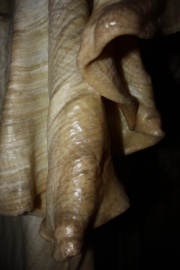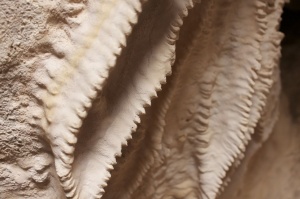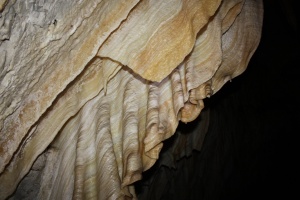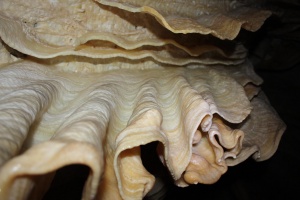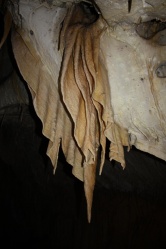Calcite (Inventory)/Drapery
From LagWiki
(Added some images) |
(Move the gallery) |
||
| Line 4: | Line 4: | ||
Draperies are flowstone, dripstone formations which appear on the ceiling or walls. They are formed by a ribbon of water leaving a trail of calcite. The result is a sheet of hanging flowstone. They curve in graceful lines much like a hanging piece of cloth. Draperies come in all sizes from very small to enormous. Draperies may extend all the way to the floor; but, if not, almost always have a noticeable slant along their lower edge and may terminate in a [[Calcite (Inventory)/Stalactite|stalactite]]. The lower edge may be smooth or decorated with regularly spaced beads or teeth like a saw blade. The color can vary greatly; and, due to changes in mineral content of the water over time, colorful horizontal stripes or bands can form within the drapery. These striped draperies are sometimes known affectionately as "cave bacon". | Draperies are flowstone, dripstone formations which appear on the ceiling or walls. They are formed by a ribbon of water leaving a trail of calcite. The result is a sheet of hanging flowstone. They curve in graceful lines much like a hanging piece of cloth. Draperies come in all sizes from very small to enormous. Draperies may extend all the way to the floor; but, if not, almost always have a noticeable slant along their lower edge and may terminate in a [[Calcite (Inventory)/Stalactite|stalactite]]. The lower edge may be smooth or decorated with regularly spaced beads or teeth like a saw blade. The color can vary greatly; and, due to changes in mineral content of the water over time, colorful horizontal stripes or bands can form within the drapery. These striped draperies are sometimes known affectionately as "cave bacon". | ||
| - | <gallery | + | ==References== |
| + | *Palmer, Arthur N. (2007) ''Cave Geology'' CAVE BOOKS, Dayton, OH p 282 ISBN-13: [[Special:Booksources/978-0-939748-66-2|978-0-939748-66-2]], ISBN-10: [[Special:Booksources/0-939748-66-5|0-939748-66-5]] | ||
| + | |||
| + | ==Drapery, Calcite== | ||
| + | <gallery perrow=2 widths=300px heights=250px> | ||
File:Beaded curtain.jpg|Beaded draperies | File:Beaded curtain.jpg|Beaded draperies | ||
File:Draperies.JPG|Draperies | File:Draperies.JPG|Draperies | ||
| Line 10: | Line 14: | ||
File:Draperies 3.JPG|Draperies | File:Draperies 3.JPG|Draperies | ||
</gallery> | </gallery> | ||
| - | |||
| - | |||
| - | |||
{{Cave inventory}} | {{Cave inventory}} | ||
Current revision as of 16:42, 9 August 2013
The Drapery field of the Calcite section is used to record stations that have a drapery.
Draperies are flowstone, dripstone formations which appear on the ceiling or walls. They are formed by a ribbon of water leaving a trail of calcite. The result is a sheet of hanging flowstone. They curve in graceful lines much like a hanging piece of cloth. Draperies come in all sizes from very small to enormous. Draperies may extend all the way to the floor; but, if not, almost always have a noticeable slant along their lower edge and may terminate in a stalactite. The lower edge may be smooth or decorated with regularly spaced beads or teeth like a saw blade. The color can vary greatly; and, due to changes in mineral content of the water over time, colorful horizontal stripes or bands can form within the drapery. These striped draperies are sometimes known affectionately as "cave bacon".
References
- Palmer, Arthur N. (2007) Cave Geology CAVE BOOKS, Dayton, OH p 282 ISBN-13: 978-0-939748-66-2, ISBN-10: 0-939748-66-5
Drapery, Calcite
